
Pomona is a rural town and locality in the Shire of Noosa, Queensland, Australia. In the 2016 census the locality of Pomona had a population of 2,910 people. Pomona is located around 135 kilometres north of Brisbane. It is located at the base of Mount Cooroora at the northern end of the Sunshine Coast.

Freemasons' Hall in London is the headquarters of the United Grand Lodge of England and the Supreme Grand Chapter of Royal Arch Masons of England, as well as being a meeting place for many Masonic Lodges in the London area. It is located in Great Queen Street between Holborn and Covent Garden and has been a Masonic meeting place since 1775.

The Masonic Temple is a heritage-listed masonic temple at 311 Ann Street, Brisbane City, City of Brisbane, Queensland, Australia. It was designed by Lange Leopold Powell of Atkinson, Powell and Conrad and was built from 1928 to 1930 by George Alexander Stronach & Son. It is also known as the Masonic Memorial Temple. It was added to the Queensland Heritage Register on 21 October 1992.
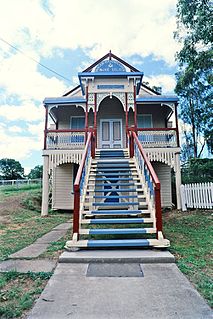
Yangan Masonic Hall is a heritage-listed masonic hall at 36 King Street, Yangan, Southern Downs Region, Queensland, Australia. It was built from 1898 to 1957. It is also known as Yangan Masonic Temple and was formerly the Yangan School of Arts. It was added to the Queensland Heritage Register on 21 October 1992.

St George's Masonic Centre is a heritage-listed masonic lodge at 50A Guy Street, Warwick, Southern Downs Region, Queensland, Australia. It was designed by William Wallace and built from 1886 to 1887. It was added to the Queensland Heritage Register on 21 October 1992.

Majestic Theatre is a heritage-listed theatre at 3 Factory Street, Pomona, Shire of Noosa, Queensland, Australia. It was added to the Queensland Heritage Register on 5 February 2009.

The Pomona Police Station and Court House is a heritage-listed former police station at Red Street, Pomona, Shire of Noosa, Queensland, Australia. It was built in 1934. It was added to the Queensland Heritage Register on 27 May 2005.
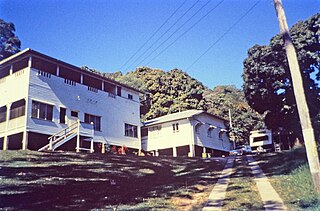
Halse Lodge is a heritage-listed boarding house at 17 Noosa Drive, Noosa Heads, Shire of Noosa, Queensland, Australia. It was built from 1880s to 1920s. It is also known as Bay View and Hillcrest Guest House. It was added to the Queensland Heritage Register on 30 April 1997.
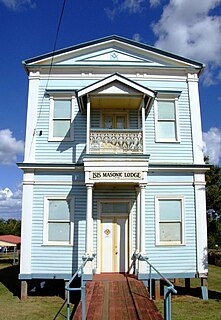
Isis Masonic Lodge is a heritage-listed masonic temple at 18 Macrossan Street, Childers, Bundaberg Region, Queensland, Australia. It was designed by F H Faircloth and built from 1897 to 1909. It is also known as Corinthian Lodge. It was added to the Queensland Heritage Register on 28 April 2000.

Mount Morgan Masonic Temple is a heritage-listed masonic temple at 2 Gordon Street, Mount Morgan, Rockhampton Region, Queensland, Australia. It was designed by Eaton & Bates and built in 1903 by Newman Brothers. It was added to the Queensland Heritage Register on 21 October 1992.
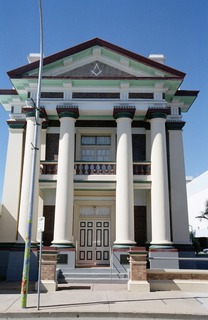
Mackay Masonic Temple is a heritage-listed masonic temple at 57 Wood Street, Mackay, Mackay Region, Queensland, Australia. It was designed by F. H. Faircloth and built in 1925 by William Ptrick Guthrie. It is also known as Masonic Hall. It was added to the Queensland Heritage Register on 14 August 2009.
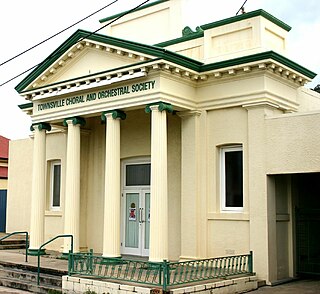
Townsville Masonic Hall is a heritage-listed former masonic temple at 485-493 Sturt Street, Townsville CBD, City of Townsville, Queensland, Australia. It was designed by W G Smith & Sons and built in 1889 by Sparre & Hansen. It is also known as Assembly of God Hall, Calvary Temple, Townsville Choral & Orchestral Society Building, Townsville Choral Society Inc. Building, and Townsville Choral and Orchestral Society Building. It was added to the Queensland Heritage Register on 21 October 1992.

Barcaldine Masonic Temple is a heritage-listed masonic temple at 39 Beech Street, Barcaldine, Barcaldine Region, Queensland, Australia. It was built in 1900. It is also known as Comet Masonic Temple. It was added to the Queensland Heritage Register on 21 October 1992.

Blackall Masonic Temple is a heritage-listed masonic temple at Hawthorn Street, Blackall, Blackall-Tambo Region, Queensland, Australia. It was built in 1908. It was added to the Queensland Heritage Register on 21 October 1992.

Charters Towers Masonic Lodge is a heritage-listed masonic temple at 20 Ryan Street, Charters Towers City, Charters Towers, Charters Towers Region, Queensland, Australia. It was built from 1887 to 1897. It was added to the Queensland Heritage Register on 21 October 1992.

Mount Perry Masonic Lodge is a heritage-listed masonic temple at Isabella Street, Mount Perry, North Burnett Region, Queensland, Australia. It was built in 1904. It was added to the Queensland Heritage Register on 21 October 1992.

Cairns Masonic Temple is a heritage-listed former masonic temple at 8 Minnie Street, Cairns City, Cairns, Cairns Region, Queensland, Australia. It was built from 1934 to 1935. It was added to the Queensland Heritage Register on 28 August 1998.

Our Lady of the Sacred Heart Church is a heritage-listed Roman Catholic church at 120 Douglas Street, Thursday Island, Shire of Torres, Queensland, Australia. It was built from c. 1885 to c. 1905. It was added to the Queensland Heritage Register on 7 December 1998.

Maitland Lodge of Unity Masonic Hall and Lodge is a heritage-listed masonic lodge and masonic hall at 5 Victoria Street, Maitland, City of Maitland, New South Wales, Australia. It was designed by J. W. Pender and built from 1886 to 1927. The property is owned by Maitland Lodge of Unity. It was added to the New South Wales State Heritage Register on 19 December 2014.





















